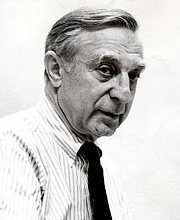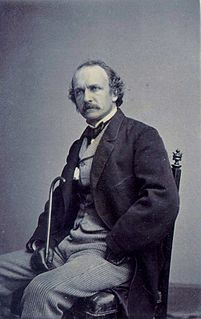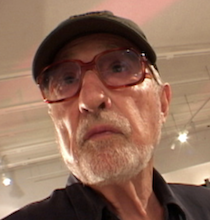Related Research Articles

Thomas Clayton Wolfe was an American novelist of the early 20th century.
Milton Clark Avery was an American modern painter. Born in Altmar, New York, he moved to Connecticut in 1898 and later to New York City. He was the husband of artist Sally Michel Avery and the father of artist March Avery.

Bertram Grosvenor Goodhue was an American architect celebrated for his work in Gothic Revival and Spanish Colonial Revival design. He also designed notable typefaces, including Cheltenham and Merrymount for the Merrymount Press. Later in life, Goodhue freed his architectural style with works like El Fureidis in Montecito, one of the three estates designed by Goodhue.

James Renwick Jr. was an American architect in the 19th century. The Encyclopedia of American Architecture calls him "one of the most successful American architects of his time".

Max Abramovitz was an American architect. He was best known for his work with the New York City firm Harrison & Abramovitz.

Samuel Lovett Waldo was an American portrait painter.

Felix Octavius Carr Darley was an American illustrator, known for his illustrations in works by well-known 19th-century authors, including James Fenimore Cooper, Charles Dickens, Mary Mapes Dodge, Nathaniel Hawthorne, Washington Irving, George Lippard, Henry Wadsworth Longfellow, Donald Grant Mitchell, Clement Clarke Moore, Francis Parkman, Harriet Beecher Stowe and Nathaniel Parker Willis.

David Vincent Hayes was an American sculptor.

Arthur Burdett Frost, usually cited as A. B. Frost, was an American illustrator, graphic artist, painter and comics writer. He is best known for his illustrations of Brer Rabbit and other characters in the Joel Chandler Harris' Uncle Remus books.

Randolph Rogers was an American Neoclassical sculptor. An expatriate who lived most of his life in Italy, his works ranged from popular subjects to major commissions, including the Columbus Doors at the U.S. Capitol and American Civil War monuments.

Anni Albers was a German textile artist and printmaker credited with blurring the lines between traditional craft and art.
Besides surface qualities, such as rough and smooth, dull and shiny, hard and soft, textiles also includes colour, and, as the dominating element, texture, which is the result of the construction of weaves. Like any craft it may end in producing useful objects, or it may rise to the level of art.

Look Homeward, Angel: A Story of the Buried Life is a 1929 novel by Thomas Wolfe. It is Wolfe's first novel, and is considered a highly autobiographical American coming-of-age story. The character of Eugene Gant is generally believed to be a depiction of Wolfe himself. The novel briefly recounts Eugene's father's early life, but primarily covers the span of time from Eugene's birth in 1900 to his definitive departure from home at the age of 19. The setting is a fictionalization of his home town of Asheville, North Carolina, called Altamont, Catawba, in the novel.

Guy Carleton Wiggins NA was an American impressionist painter. He was the president of the Connecticut Academy of Fine Arts, and a member of the Old Lyme Art Colony. He did many paintings of New York City's snowy streets, landmarks and towering skyscrapers during winter.
Deane Galloway Keller was an American artist, academic and author. Keller was a draftsman, painter, sculptor, and teacher who instructed students in the visual arts for forty years, most notably in figure drawing and the artistic application of human anatomy. He is credited with explaining that "drawing offers a unique record of an encounter with a culture, of experience transformed from fleeting moment to lasting resonance."
Wallace Ronald Roy, is an American writer of children's fiction, primarily mysteries for young readers. He is best known for the series A to Z Mysteries, Capital Mysteries, and Calendar Mysteries.

Donn BarberFAIA was an American architect.
Dorothy Hope Smith was an American artist and painter, best known as the artist who drew the Gerber Baby.
William Garrett Price was an American artist, cartoonist and illustrator. He is remembered for cartoons and cover illustrations in The New Yorker and for children's book illustrations.
Deborah Dancy, also known as Deborah Muirhead, is an American painter of large-scale abstractions in oil; she is also a printmaker and mixed media artist. Her work is also known to encompass digital photography. In 1981, she began to teach at the University of Connecticut, Storrs, where she taught painting for thirty-five years until her retirement in 2017. She has received awards such as a John Simon Guggenheim Foundation Fellowship, Women’s Studio Workshop Studio Residency Grant, and a YADDO fellowship.

Francis Mattson Hines (1920–2016) was an American artist known for his large-scale public wrapped works. Many of his paintings and drawings were found in a Connecticut dumpster in 2017 and will be re-exhibited in 2022.
References
- 1 2 3 4 5 6 7 8 "HARRIS, HARVEY SHERMAN". Hartford Courant. 1999-03-17. Retrieved 2022-03-21.
- 1 2 3 4 5 "Ann Connelly Fine Art: Harvey Sherman Harris" . Retrieved 2022-03-21.
- 1 2 3 4 5 "The Harvey Harris Illustrations for Look Homeward, Angel". Thomas Wolfe Society. 2008. Retrieved 2022-03-21.
- 1 2 3 4 5 6 7 8 9 10 "Harvey Harris" . Retrieved 2022-03-21.
- 1 2 3 4 "Retrospective of artist Harvey Harris works opens March 28 at Ann Connelly Fine Art". The Advocate. 2019-03-23. Retrieved 2022-03-21.
- ↑ "Harvey Sherman Harris" . Retrieved 2022-03-21.
- ↑ "Object Record" . Retrieved 2022-03-21.
- ↑ "Lot.1053 Harvey Sherman Harris (American/Louisiana, 1915-1999), "G.I. Basketball" and "G.I. Boxing", 1943, 2" . Retrieved 2022-03-21.
- ↑ "Children's Book Artist The City Alphabet Book by Harvey Harris Pre-Publication Mock-Up Book and Illustration Art Group (Samuel Lowe, c. 1940s)" . Retrieved 2022-03-21.